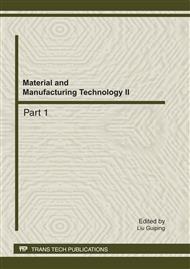p.42
p.48
p.53
p.58
p.63
p.68
p.73
p.77
p.80
Preparation of CoFe2O4 Nanocrystallite by Sol-Gel Combustion Synthesis and Evaluation of its Reaction Performance
Abstract:
Sol-gel combustion synthesis method was adopted to prepare nano-sized CoFe2O4 using urea as fuel. The as-synthesized CoFe2O4 powders were characterized through such experimental means as Fourier transform infrared spectroscopy (FTIR), TG (thermogravimetric)–DSC (differential scanning calorimetry), X-ray diffraction (XRD), field-scanning electron microscopy (FSEM). FTIR analysis and XRD analysis revealed that the dried CoFe2O4 gel was formed by the coordination of metal with O, and consisted of various phases through the hydrolysis of urea and metal nitrates along with the coordination of the various groups produced. And then, TG-DSC analysis of the dried CoFe2O4 gel under air atmosphere indicated that there are two remarkable exothermic reactions occurring, related to the redox reactions between urea and nitrates used, and as-synthesized CoFe2O4 was porous due to the emission of large amount of gases during preparation. Finally, three cycles of temperature-programmed reduction (TPR) coupled with temperature-programmed oxidization (TPO) tests were conducted on the AutoChem 2920 system to show the good reaction and sintering-resistance performance for the synthesized CoFe2O4.
Info:
Periodical:
Pages:
63-67
Citation:
Online since:
September 2011
Authors:
Keywords:
Price:
Сopyright:
© 2012 Trans Tech Publications Ltd. All Rights Reserved
Share:
Citation:


